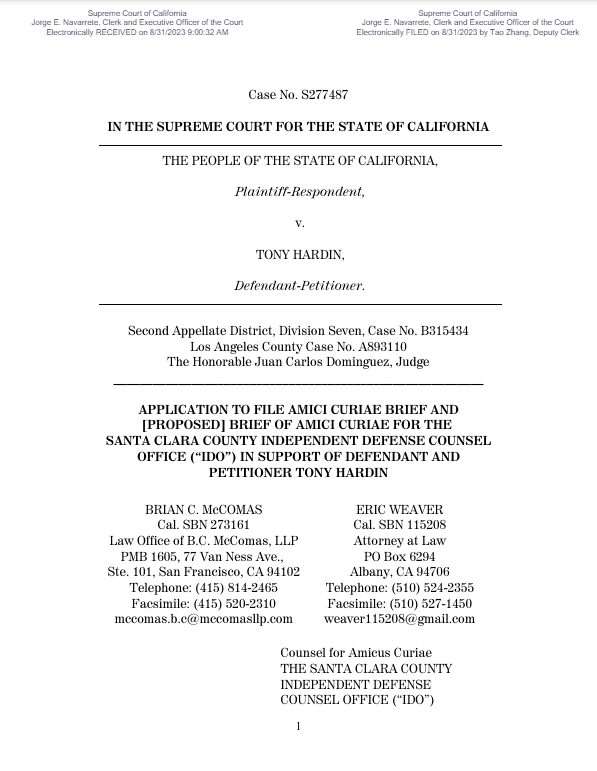
Summary of Argument
Youthful offender parole is authorized by age at the time of the offense – under 26 years – in line with the Supreme Court’s recognition that the attributes of youth are not “crime-specific.” (Miller v. Alabama (2012) 567 U.S. 460, 473.) Eligible youths may earn release by demonstrating rehabilitation, even if the sentence exceeds their natural lifetime. (In re Jones (2019) 42 Cal.App.5th 477, 486-487, concurring opn. of Pollak, P. J.) Adolescent persons sentenced to Life Without the Possibility of Parole (“LWOP”), however, are ineligible for relief from incarceration for offenses committed before age 26, even if completely rehabilitated today. These youths are unfairly “condemned to live virtually [their] entire life in ignominious confinement, stripped of any opportunity or motive to redeem [themself] for an act attributable to the rash and immature judgment of youth.” (People v. Davis (1981) 29 Cal.3d 814, 832, fn. 10.) The disparate treatment of youthful persons under Penal Code section 3051 was remedied in People v. Hardin (2022) 84 Cal.App.5th 273, 289-90, where the Second District Court of Appeal correctly recognized “that any purported legislatively recognized distinction in culpability between individuals serving a parole-eligible indeterminate life sentence and those sentenced to life without parole is illusory.” On review, the Attorney General argues that the dual purposes of “culpability” and “punishment” demonstrate “that young adult offenders who commit the most serious offenses should have no opportunity for relief from lifetime incarceration.” (Respondent’s Reply Brief (“Reply Brief”), at p. 7.) The State is wrong – similarly situated persons convicted of the most serious crimes in Santa Clara County are not receiving “like treatment” under section 3051. (See, infra, Declarations by Mara Hickey, P.I.; Dr. Kathryn Albrecht; and Drs. Rahn Minagawa, Francesca Lehman, and Carl Osborn [Attached as Exhibits A-C], infra.) There are at least three factors demonstrating that section 3051 does not apply in equal fashion by excluding those (1) most subject to socioeconomic disparities during childhood; (2) who end up in prison for life in their youth; but (3) are granted no opportunity for parole despite equal capacity for rehabilitation. Distinguishing against such youthful persons without regard to the factors leading to their imprisonment, but instead solely on “crime-specific” reasons, is unequal protection. Nor would equal application of section 3051 undo most LWOP sentences, as this Court has recognized. “The Legislature did not envision that the original sentences of eligible youth offenders would be vacated and that new sentences would be imposed to reflect parole eligibility during the 15th, 20th, or 25th year of incarceration.” (People v. Franklin (2016) 63 Cal.4th 261, 278.) Thus, youthful offender parole, like senior parole, merely offers a small number of rehabilitated people the opportunity for release – not to assess “culpability” or impose “punishment” – but “‘to account for neuroscience research that the human brain—especially those portions responsible for judgment and decision making— continues to develop into a person’s mid-20's.’” (Hardin, supra, 84 Cal.App.5th at p. 287, citation omitted.) “The continued operation of the original sentence is evident from the fact that an inmate remains bound by that sentence.” (Franklin, supra, 63 Cal.4th at p. 278.) Mr. Hardin correctly challenges section 3051, subdivision (h), for failing in its purpose of “rehabilitation.” (Answering Brief, at p. 32.) The Attorney General’s contrary analysis would have the Court disregard the historical, racial, and scientific disparities undergirding the unequal exclusion of some youths from parole based on “fictional approach[es] to statutory purpose.” (Brown v. Merlo (1973) 8 Cal.3d 855, 865, fn. 7.) This brief – through the lens of Santa Clara County – provides a more “serious and genuine judicial inquiry into the correspondence between the classification and the legislative goals.” (Newland v. Board of Governors (1977) 19 Cal.3d 705, 711, citation omitted.) The decision in Hardin must be affirmed to equally protect all similarly situated young persons under Article I, section 7 of the California Constitution, and the Eighth and Fourteenth Amendments to the United States Constitution.